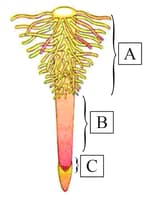MEDIUM
Earn 100
What indicates to in the below figure?


(a) Region of maturation, : Root cap,Region of meristematic activity, Root hair, Region of elongation.
(b) Root hair, Region of maturation, Region of elongation, Root cap, Region of meristematic activity.
(c) Root cap, Region of maturation, Region of elongation, Root hair, Region of meristematic activity.
(d) Region of meristematic activity, Region of elongation, Region of maturation, Root hair, Root cap.
92.76% studentsanswered this correctly
Important Questions on Morphology of Flowering Plants
EASY
EASY
EASY
EASY
EASY
MEDIUM
(a) The leaflets are modified into pointed hard thorns in Citrus and Bougainvillea
(b) Axillary buds form slender and spirally coiled tendrils in cucumber and pumpkin
(c) Stem is flattened and fleshy in Opuntia and modified to perform the function of leaves
(d) Rhizophora shows vertically upward growing roots that help to get oxygen for respiration
(e) Subaerially growing stems in grasses and strawberry help in vegetative propagation
Choose the correct answer from the options given below:
EASY
Identify A, B and C in the given diagram of the regions of root tip?

EASY
EASY
EASY
EASY
HARD
Match the column I with column II and select the correct answer.
| Column I | Column II |
| A Dahlia | 1 Nodulose roots |
| B Curcuma | 2 Nodulated roots |
| C Pea | 3 Fasciculated roots |
| D Banyan | 4 Prop roots |
EASY
EASY
MEDIUM
(A) From the region of elongation, some of the epidermal cells form root hairs.
(B) Pneumatophores are seen in Rhizophora.
(C) Adventitious roots are seen in the banyan tree.
(D) Maize and sugarcane have prop roots.
EASY
EASY
MEDIUM
MEDIUM
MEDIUM


